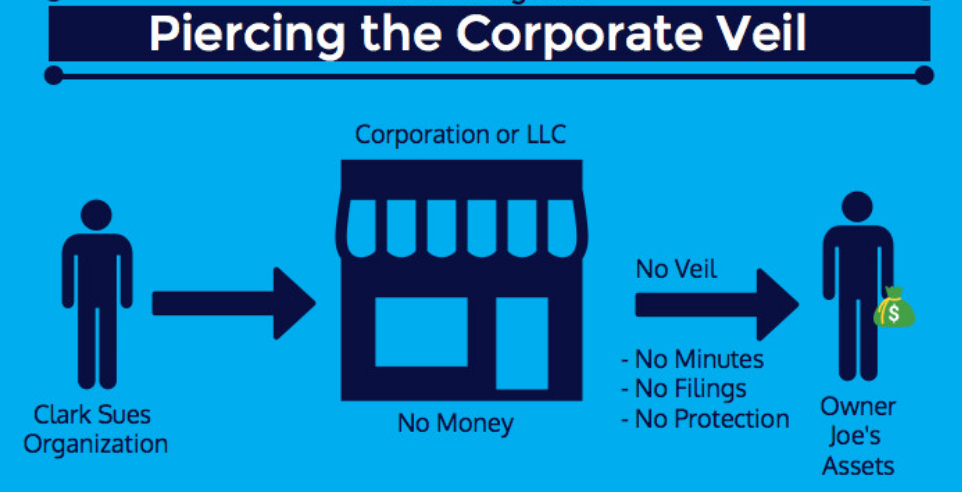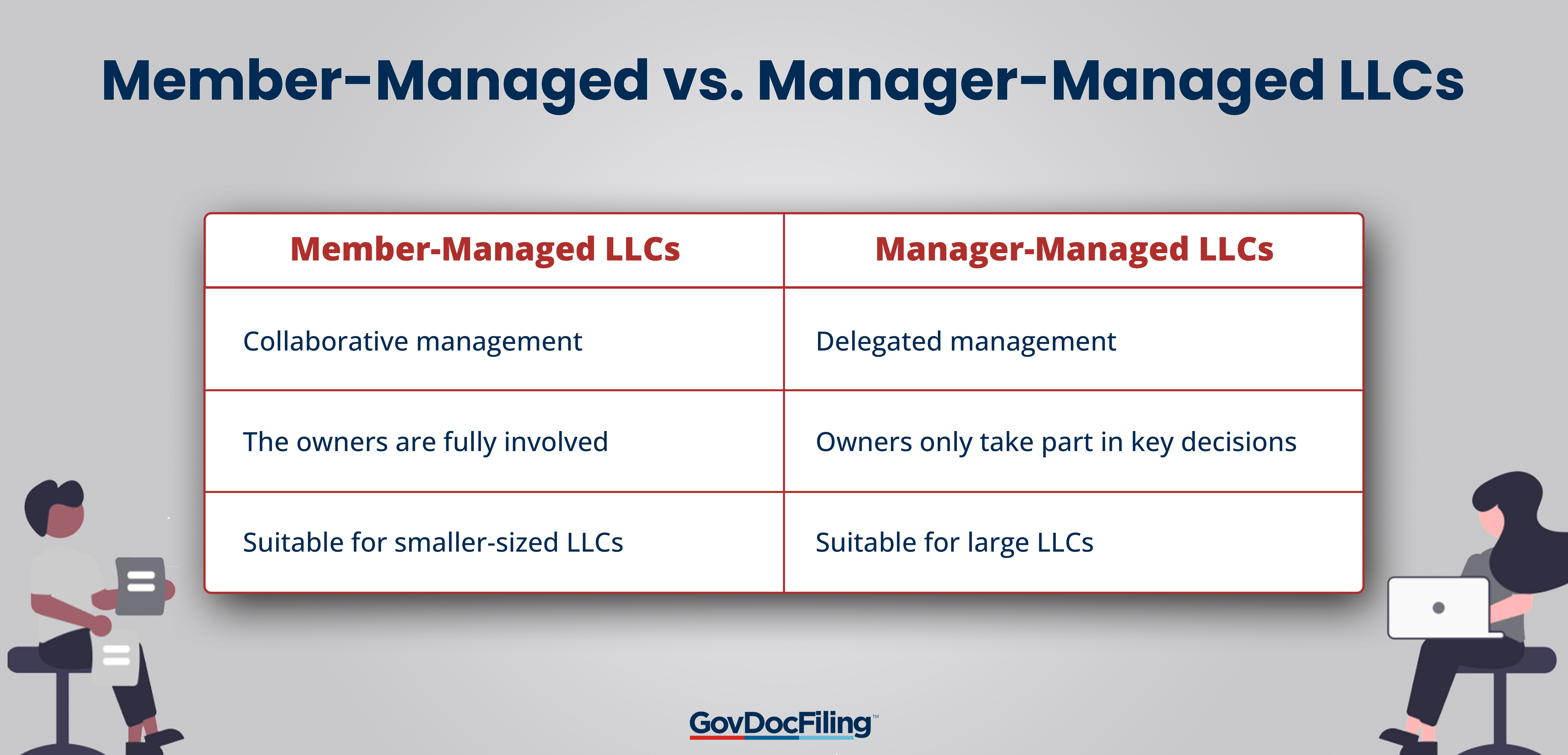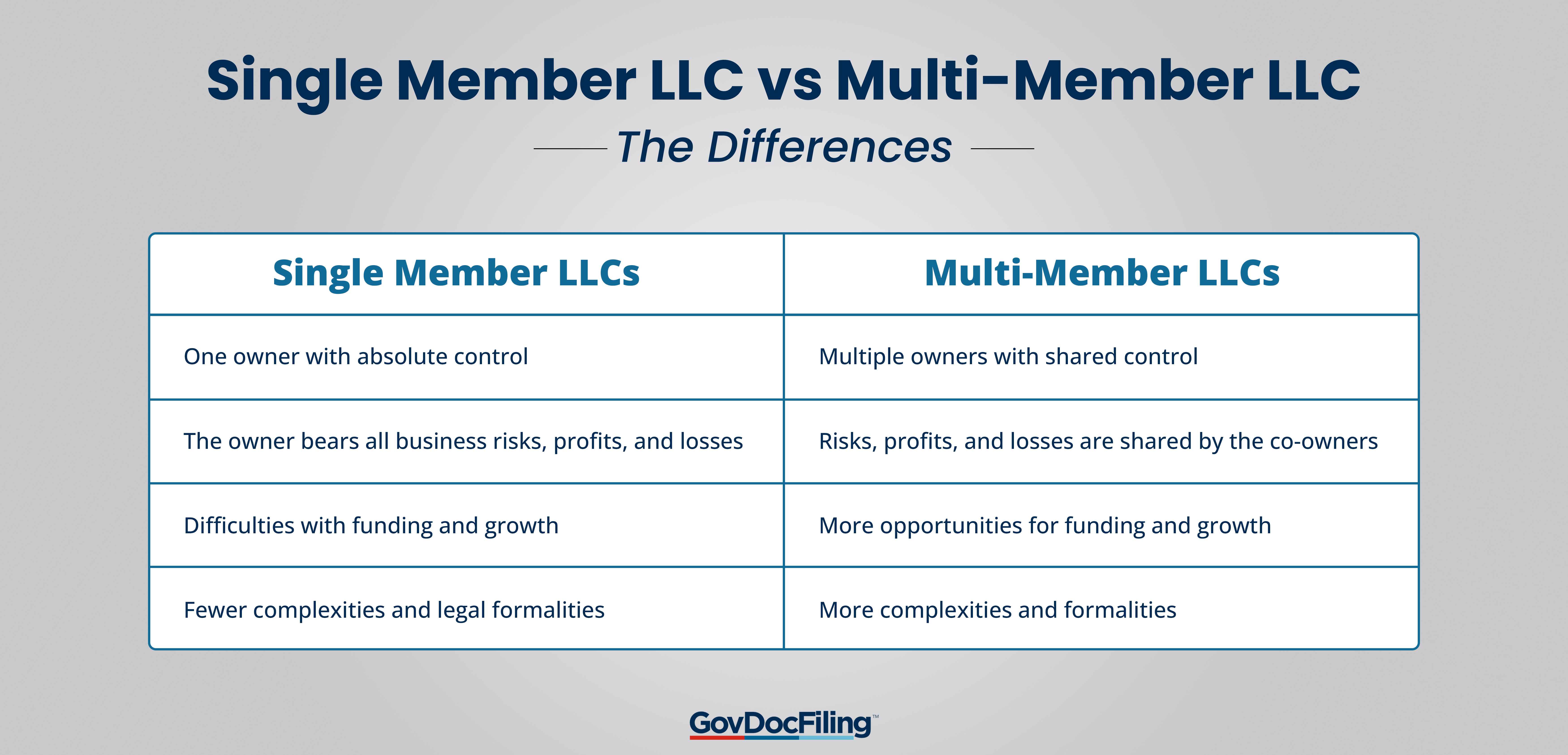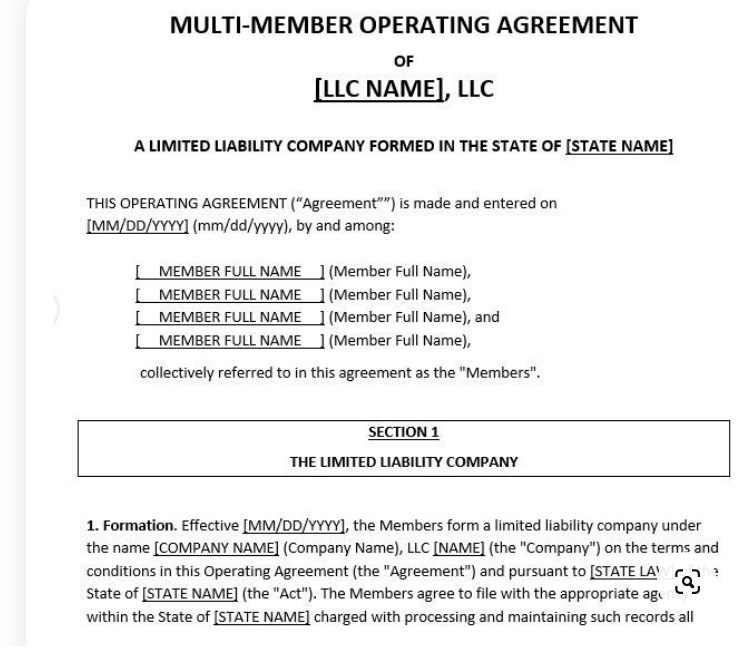Are you about to start a business and you’re faced with the single-member LLC vs. multi-member LLC dilemma? The decision can be tricky no doubt, as they share many characteristics, however with key differences.
Known in full as a Limited Liability Company, an LLC refers to a business’ legal structure. This structure protects the business owner from liability, in the same way as a corporation. Registering your business as an LLC offers limited liability protection.
It’s important to understand how a single-member LLC and a multi-member LLC work. Your choice will affect your business’s structure, taxation, liability protection, and more.
Due to this, it’s important to choose a structure that suits your business needs and goals. In this post, we’ll explain the features of single-member and multi-member LLCs, the differences, and how to choose the right option.
Let’s get started.
What are Single-Member LLCs?
Simply put, a single-member LLC is a type of limited liability company that has only one owner. This business structure has the simplicity of a sole proprietorship while also offering liability protection like a corporation.
Single-member LLCs are also known as one-owner LLCs, single-owner LLCs, single-entity LLCs, or individual LLCs.
With a single-member LLC, you own the full rights to the business venture. You’re in charge of making business decisions, investing, and overseeing all business operations.
Single-member LLCs offer flexibility and efficient management. When you register your business as a single-member LLC, you gain personal liability protection. Personal liability protection safeguards your personal assets from liability.
Furthermore, with a single-member LLC, you’ll not be required to issue ownership interests or shares. Here’s a quick rundown of the main features of a single-member LLC.
- Limited Liability Protection: A single-member LLC offers personal asset protection. This means as the sole member, business debts or company liabilities do not affect your assets.
- Formation and Maintenance: It’s quite easy and cheap to set up a single-member LLC. You’ll not be required to maintain a board of directors or shareholders like a corporation.
- At GovDocFiling we help file all necessary business formation documents with the respective government agencies on your behalf. We offer expedited processing of your application at no additional cost.
- Pass-Through Taxation: With single-member LLCs, taxation works differently. The Internal Revenue Service (IRS) treats single-member LLCs as disregarded entities during taxation.
- This means the business entity does not pay income taxes. Instead, the LLC’s profits or losses will pass to the sole owner, who will pay their tax return as usual. The owner does not need to file a separate tax return for the business.
- Simplicity and Flexibility: Single-member LLCs are typically small businesses and solo entrepreneurships. The sole owner has full autonomy over the business operations, just like a sole proprietor.
Advantages of Single-Member LLCs
Now that we’ve discussed the main features of single-member LLCs, here are the top potential benefits.
1. Limited Liability Protection
One of the major benefits a single-member limited liability company offers is limited personal liability protection. This business structure legally protects the owner from business debts and liabilities.
This means your assets will be safe even while operating as the sole owner. This business structure works for entrepreneurs who have significant personal assets they wish to protect.
If someone sues your business, for instance, your assets like your house or cars will be safe from creditors. In the eyes of the law, single-member LLCs are separate from the owners, so owners are not liable for the company’s debts and liabilities.
2. Autonomy
A single-member LLC does not require creating a board of directors or shareholders. This means you have full control over how the business runs as the owner. With a single-member LLC, you can make business decisions swiftly.
3. Tax Advantages
As mentioned earlier, the IRS considers single-member LLCs as disregarded entities for tax purposes. Simply put, single-member LLCs do not pay income tax at the business level. Rather, the LLC’s profits or losses reflect on the owner’s tax return.
This means the business entity functions like a pass-through entity. If you run a single-member limited liability company, you’ll have to report the income and expenses on your income tax return.
This makes filing income taxes easy and simple. It also prevents entrepreneurs from paying double tax—once at the business level and once on their individual tax returns.
4. Credibility
For small to medium-sized businesses, one of the major challenges is boosting credibility and attracting potential clients. Registering your business as an LLC can portray professionalism and boost your business’ credibility.
How? Potential clients and investors can see that your business is separate from you as the owner, with more legitimacy than a sole proprietorship, for example.
With your business registered as a single-member LLC, your business name will include ‘LLC’, further boosting investor confidence in your business.
5. Privacy
Entrepreneurs who desire some level of privacy can benefit from registering their businesses as a single-member LLC.
While a lot of information about the business might be public, your personal identity remains private. This is because the business will be treated as a separate legal entity.
Disadvantages of Single-Member LLCs
While single-member LLCs offer many benefits, we’ve listed some potential drawbacks you should know about.
1. Limited Personal Liability Protection
While it’s true that single-member LLCs offer personal liability protection, there are times when the law can ‘pierce the veil’. This happens if the business owner does not make a clear separation between the business entity and their personal finances.
For instance, when the owner mixes business and personal funds or mingles business assets with personal assets. Fraudulent behavior can also weaken the liability protection. Here’s an example of how this can happen.
Image via LinkedIn
Also, If the courts determine that the business hasn’t operated as a separate legal entity, it can go after the owner’s personal assets. This shows that the personal liability protection in single-member LLCs is not absolute.
2. Limited Growth Opportunities
While the autonomy and flexibility are exciting, there may be limited opportunity for growth when running single-member LLCs.
Unlike corporations, single-member LLCs cannot issue shares or bring in new owners to raise capital. This can result in financial challenges while running the business.
Also, some investors or clients may view a single-member LLC as being less credible than multi-member LLCs. The lack of governance structures and management can also be a hurdle when trying to secure loans.
Lastly, if you run a single-member LLC, you can’t participate in public offerings or issue stock.
3. Self-Employment Taxes
This is another potential drawback of single-member LLCs. Depending on where you live, you may have to pay self-employment taxes on the net income from your LLC.
Since you function as both the owner and employee, you may need to pay both taxes for Social Security and Medicare.
On the other hand, employees working at corporations typically pay less tax. Also, self-employment taxes do not apply to profits shared to shareholders as dividends.
Multi-Member LLCs
Before we explore the differences between single-member vs. multi-member LLCs, let’s see what multi-member LLCs are.
Instead of having a single owner, multi-member LLCs have multiple owners, also referred to as members. Each owner or member holds a share or ownership in the company.
While a multi-member LLC offers limited liability protection just as a single-member LLC, the protection is more robust. There is a more efficient separation of the business and the owner’s finances.
Furthermore, a multi-member LLC allows you to share profits and losses with other owners. As for management, the owners can oversee the business operations or appoint other managers. They can also decide how they want the LLC to be run, unlike corporations, which have strict management rules.
This business structure gives room for more teamwork, shared decision-making and duties, and flexibility in management. However, it’s more suitable for medium to large-scale businesses.
Here are the key features of multi-member LLCs:
- Shared Ownership: A multiple-member LLC offers room for shared ownership. The partnership configurations are diverse. This particularly works for businesses that need various skill sets or major financial capital.
- Flexibility: With a multiple-member company, you can choose a manager-managed LLC or a member-managed LLC structure. We’ll explain these in the next section.
- This business structure lets you adjust the management and ownership structure to meet certain needs and skill sets.
- Pass-Through Taxation: By default, multi-member LLCs are taxed as a partnership. This means the business entity doesn’t pay taxes. However, the taxes, profits, and losses, are shared by the individual LLC members.
The ratio depends on each member’s ownership percentage or any other agreed formula.
- Limited Liability Protection: Just like single-member LLCs, multiple-member LLCs protect each owner’s assets from business debts and legal issues.When choosing a multi-member LLC, it’s important to understand the two ways it can be structured. Multi-member LLCs can be collaborative or delegated i.e. member-managed or manager-managed.
Member-Managed LLCs
This multiple-member LLC structure is collaborative. This means all owners participate to a certain degree in running the business. Under this type, each owner is involved in making daily decisions and developing strategies.
In member-managed LLCs, each owner has equal rights to make decisions, unless stated otherwise in the LL operating agreement. This multi-member LLC structure is suitable for smaller-sized LLCs or businesses where the owners prefer more involvement.
Manager-Managed LLCs
Owners of multi-member LLCs can choose to delegate the business management to one or multiple managers. The delegated authority can also include the business owners or outsiders.
This structure is more common with larger businesses with various business partners, some of whom prefer to be passive or private. The business owners only take part in key business decisions.
For running a multi-member LLC, the operating agreement should include the preferred structure, responsibilities, and other crucial details.
Advantages of Multi-Member LLCs
Multi-member LLCs offer several key advantages. Here are some of the main advantages of running a multi-member LLC.
1. Shared Responsibilities
A key advantage of multiple-member LLCs is the room for shared management responsibilities. With multiple co-owners, the workload is shared, and running the business is more efficient.
Even better, the management responsibilities can be delegated, as in the case of manager-managed LLCs.
Furthermore, this LLC structure gives room for diverse skill sets and ideas to help expand the business. Each co-owner has a say in the decision-making process and can bring new perspectives.
2. More Resources
Unlike single-member LLCs, multi-member LLCs have multiple owners who can all supply resources and capital.
This type of LLC offers more financial resources, leading to more potential for growth. Multi-member LLCs can reduce the financial burden on their members.
Typically, multi-member LLCs have more financing options. Since investors trust multi-member LLCs more and consider them more credible, it’s easier for these to secure funding.
3. Tax Advantages
Multi-member LLCs can also provide tax advantages. Unlike single-member LLCs where the profits and losses are taken by the owner, it’s quite different in multi-member LLCs.
Multi-member LLCs can choose to share profits or losses in any agreed structure. This can help with tax planning in unincorporated LLCs. This means each co-owner can optimize their tax liabilities.
Also, pass-through taxation can offer significant benefits to the business. This means the income taxes are passed through to the owners, avoiding several complexities.
4. Liability Protection
Just like single-member LLCs, multi-member LLCs also protect the owners’ assets from business liabilities. This personal liability protection is even stronger as there’s a better separation of the business and its owners.
5. Increased Credibility
Compared to a business owned by just one person, multi-member LLCs seem more credible. This is because investors and clients can view multi-member LLCs as being more established.
Also, multi-member LLCs have well-defined structures and agreements that guarantee stability, giving more room for partnerships.
Disadvantages of Multi-Member LLCs
It’s important to be aware of the potential disadvantages of multi-member LLCs. We’ll explain them in this section.
1. Scope for Conflicts
When there are multiple co-owners, there can be conflicts due to the different perspectives and ideas. For instance, different opinions during decision-making can slow down the business processes.
Without well-defined agreements and clear processes, potential conflicts can occur. These can hinder the growth of the business if they happen frequently.
In addition, there may be potential conflicts during profit and loss sharing. In cases where the time, efforts, or capital contributed by the owners vary, it may result in disagreements.
That’s why it’s a good idea to have a comprehensive and well-documented LLC operating agreement stipulating all the guidelines.
2. More Administrative Requirements
Compared to single-member LLCs, multi-member LLCs involve more administrative demands. These could include filing operating agreements, regular management meetings, and profit and loss allocation.
These alongside the tax and legal processes may make multi-member LLCs complex to operate compared to single-member LLCs.
3. Dissolution Issues
While having multiple owners can be beneficial, issues may arise when one or more members decide to leave the business.
Without a clear and predefined process, it might be difficult to handle exits and withdrawals from the LLC. Situations like member buyouts, payoffs, or retirements can get complicated very quickly.
Furthermore, member withdrawals can affect decision-making and funding. If a valuable member leaves unexpectedly, the loss could affect the smooth running of the LLC.
Single Member LLC vs Multi Member LLC
Now, let’s compare single-member LLCs vs. multi-member LLCs, including their similarities and differences.
Single-Member LLC vs Multi-Member LLCs: The Similarities
While single-member LLCs and multi-member LLCs have key differences, they share some features. Here’s a closer look at four key similarities.
1. Limited Liability Protection
A key similarity between both options is the liability protection they provide. Whether it’s a single owner or multiple co-owners, their personal assets are protected from business debts and litigation.
When you register a business as an LLC, the business entity becomes separate from the owner or co-owners.
This protection stays on as long the LLC members maintain a clear line between their personal finances and business finances. Having a separate business bank account helps with that.
2. Flexibility
Though the degree of management flexibility varies, they both offer flexibility in managing the business. For instance, in single-member LLCs, you can choose to run the business according to your preference.
Multi-member LLCs also offer management flexibility. The members can decide who they want to run the business after detailed discussion and careful consideration. They may also choose to appoint managers to run the business or do it themselves.
Both business structures give room for adaptability. The management structure can be modified to adjust to market demands as the business grows. However, it’s important to delegate effectively when opting for a manager-managed LLC structure.
3. Pass-Through Taxation
The IRS considers both single-member and multi-member LLCs to be disregarded entities by default. This means the business entity itself doesn’t pay taxes on the business income.
However, the taxes pass through to the owner or co-owners. They then report it on Schedule C or individual personal tax returns.
For multi-member LLCs, each co-owner will get their share of the profits and losses based on the agreed percentage. However, they’ll pay taxes on their entire income, which may include multiple sources.
This method makes tax filing easy in both business structures.
4. Ease of Formation
When compared to incorporating a business, creating single or multi-member LLCs is easier and less expensive.
Depending on the state, you can file the formation documents with the designated state agency and follow the stated guidelines to create a single-member or multi-member LLCS.
This process is easy for entrepreneurs and doesn’t involve the complexities involved in business incorporation.
Single Member LLC vs Multi-Member LLC: The Differences
Here are the striking differences between single-member and multi-member LLCs.
1. Ownership
The main difference between single and multi-member LLCs lies in the ownership structure. A single-member LLC has a sole member who has absolute control over the business. The owner also manages the profits and losses.
On the other hand, multi-member LLCs have a more collaborative structure. Under this business structure, you can adopt diverse skillsets and resources.
The co-owners make joint decisions and share the profits and losses based on a defined structure. In multi-member LLCs, the business can add more members and some members may even leave.
2. Taxation and Profit Sharing
While both options benefit from pass-through taxation, there are some differences. For single-member LLCs, the profits and losses go to the sole owner’s personal tax return.
The sole owner bears all the profits, losses, and business risks. For multi-member LLCs, the profits, losses, and business risks are shared by the co-owners.
However, they determine the share based on the ownership percentage. The tax implications in multi-member LLCs depend on a predefined LLC operating agreement.
3. Funding and Growth
Because of the single-owner structure, single-member LLCs may face difficulties in raising capital and expanding the business.
Also, single-member LLCs are often seen as less credible than multi-member LLCs. The sole owner might face difficulties in securing large loans or getting funding from investors.
On the other hand, multi-member LLCs may have better opportunities for funding and growth. The members can pool their resources and skill sets to scale the business.
Also, investors and lenders view multi-member LLCs as more trustworthy because of the ownership structure.
4. Management
There are also key differences in management. In single-member LLCs, the sole owner manages the business and can make decisions quickly.
In multi-member LLCs, the decision-making may be slower due to the number of owners and the need to reach an agreement.
Additionally, multi-member LLCs can be managed directly by the co-owners or a designated co-owner. They can also be run by managers. However, the co-owners make the key business decisions.
5. Complexity
While both structures offer limited liability protection, multi-member LLCs can be more complex than single-member LLCs. Single-member LLCs have fewer business and legal formalities.
For multi-member LLCs, there’s a need to have a well-defined operating agreement. This agreement details the ownership percentages, the profit and loss sharing, and other key information.
Lastly, multiple-member LLCs may face further complexities with handling disputes, member buyouts, and taxation.
How to Choose Between Single-Member and Multi-Member LLCs
Starting your business can be exciting, though choosing the right structure can be overwhelming. After determining whether an LLC is right for you, here are the top factors to consider when choosing between single and multi-member LLCs.
1. Ownership
One of the main factors that should influence your choice between single-member LLCs vs multi-member LLCs is your ownership preference.
If you prefer to retain sole control over your limited liability company, then a single-member LLC will be suitable for you. However, keep in mind that you’ll bear the risks alone.
On the other hand, if you prefer to have multiple owners or if you’re starting a business with friends, a multi-member LLC is preferable. However, the shared responsibilities and decision-making need to be handled effectively to avoid conflicts.
2. Financial Resources
Consider your budget and financial needs. When running a single-member LLC, the burden for financial resources rests solely on you.
Also, running a single-member LLC can limit your chances of getting loans or investors easily.
Therefore, if your business requires a lot of funding, then it’s best to register as a multi-member LLC. With multi-member LLCs, the members can raise capital together to run the business.
3. Sole Management vs. Collaboration
If your business is small and doesn’t require much effort in management, then a single-member LLC should work.
Also, if you don’t need diverse perspectives or skill sets to run the business, then a one-member LLC is suitable.
However, if you prefer a partnership-style business structure, then you can opt for a multi-member LLC. With a multi-member LLC, you can share the workload and employ different skill sets.
4. Long-Term Goals
Your long-term goals for the business should also influence your choice between a single-member LLC vs a multi-member LLC.
If you plan to keep the business small to medium-sized, then a single-member LLC might be suitable. However, if the long-term goals involve ambitious expansion plans, then you might need multiple members in the business.
5. Personal Assets
While both single and multi-member LLCs offer limited liability protection, the level of protection differs. For instance, the courts can determine when there’s no longer a separation between the business entity and your personal assets.
When this happens while operating a single-member LLC, then the limited liability protection may be removed.
For multi-member LLCs, the limited liability protection is stronger. Due to the multiple ownership, the assets of the members have better protection. Also, some states may offer better liability protection for multiple-member LLCs.
6. Exit Strategy
The exit strategy for a single-member LLC is simpler than for multi-member LLCs.
If you plan to transfer the ownership of the business or sell the business in the future, then a single-member LLC might be the right choice for you.
Multi-member LLCs have a more complex exit strategy. Some contracts and agreements outline the process of selling or exiting the business.
How to Register an LLC: A Step-by-Step Guide
After understanding the similarities and differences between single-member vs multi-member LLCs, you can now choose the right option for your business.
Now, let’s discuss the process of how to register an LLC.
1. Choose a Business Name
First, you should select a name that shows your brand identity and is easy for clients to remember. It’s important to check if the chosen name is available in your state. Here are the best practices for choosing a business name.
Image via GovDocFiling
Many state business filing websites offer a business entity search tool. You can also make a trademark search through the United States Patent and Trademark Office (USPTO) website to ensure the name is available.
Some providers offer help with confirming the availability of your business name. LegalZoom, for instance, offers a name check service to confirm that your preferred business name is available, alongside other important services you need to register your LLC.
However, If you plan to register a business name that’s different from your LLC’s legal name, you’ll need to file a DBA with your state or local government. MyCompanyWorks can help you easily file your DBA online.
2. Appoint a Registered Agent
As an LLC, you’ll need a registered agent. This is an individual or organization that receives legal documents and notices on behalf of the business entity.
The registered agent must have a physical street address within the state of registration. Also, the resident agent must be available during regular business hours to accept legal documents and notices.
You can appoint yourself as the registered agent for your LLC, though it is more convenient to hire a professional registered agent service provider.
3. File Articles of Organization
This is the official formation document that formally creates your LLC with your state. It is part of the important legal requirements for starting an LLC.
Articles of Organization include your LLC’s name, address, registered agent information, and the names and addresses of the LLC’s members. To make the process easier, you consult a provider that offers the best LLC services to take you through the process.
You can get the Articles of Organization form from your state’s business filing website or office. In most states, you can file online for faster processing. However, there’s usually a filing fee associated with submitting the Articles of Organization.
GovDocFiling offers a simplified application for both state and federal filing. Instead of going through the process by yourself, we offer simple and expedited processing. Also, we offer filing services at a cheaper rate, compared to a lawyer or accountant.
4. Create an Operating Agreement
This is optional and isn’t needed if you’re running a single-member LLC. An operating agreement is a legal document that details the internal governance of your LLC.
It states how profits and losses will be shared among members, and the company’s voting rights, management structure, and procedures for dissolving the LLC. Here’s a template for a multi-member LLC.
Image via Pinterest
It’s best to consult a lawyer when drafting an operating agreement for a multi-member LLC. Rocket Lawyer, for example, offers assistance with creating legal documents.
Though it may not be required by law, an operating agreement can help resolve potential disputes among members. It’s vital to have one when running a multi-member LLC.
5. Acquire an EIN
The Employer Identification Number, also known as the Tax ID serves as the business’s identification number for tax purposes. While it may not be compulsory for LLCs, it is beneficial.
It helps create a separate tax identity for the business and makes tax filing smoother. You can get an EIN by applying online through the IRS.
6. Obtain Business Licenses and Permits
Depending on your business activity and location, you may also need to obtain additional licenses and permits to operate legally.
After creating your LLC successfully, ensure you balance the books and pay the required taxes. You can get help with bookkeeping and tax preparation by consulting third-party providers like Bench that offer this specialized service.
FAQs
Q1. What is the major difference between a single-member LLC and a multi-member LLC?
The major difference lies in ownership. A single-member LLC has one owner and is operated by one owner. A multi-member LLC has two or more owners.
Q2. Is the liability protection offered by single-member and multi-member LLCs the same?
While both LLCs offer limited liability protection, multi-member LLCs may offer a stronger level of protection due to the number of members.
Q3. Which LLC form offers more control?
Single-member LLCs offer complete control over the decision-making and overall business operations. Under multi-member LLCs, the control is shared among the co-owners.
Q4. Which structure is better for business growth?
A multi-member LLC might offer better opportunities for business growth. This is as a result of multiple skill sets and resources from the members. Also, multi-member LLCs are more attractive to lenders and investors.
Q5. How should I choose between a single-member and a multi-member LLC?
The key factors that should affect your choice include ownership preference, financial resources, long-term goals, and succession planning.
Ready to Get Started?
Registering your business as an LLC gives you personal asset protection. While you can choose between a single-member or a multi-member LLC, each option has its pros and cons.
Ultimately, the choice rests on your specific needs and long-term goals. Therefore, it’s important to weigh your options, plan carefully, and choose the structure that can help your business succeed. Best wishes!
About the author
From selling flowers door-to-door at hair salons when he was 16 to starting his own auto detailing business, Brett Shapiro has had an entrepreneurial spirit since he was young. After earning a Bachelor of Arts degree in Global and International Studies from the University of California, Santa Barbara, and years traveling the world planning and executing cause marketing events, Brett decided to test out his entrepreneurial chops with his own medical supply distribution company.
During the formation of this business, Brett made a handful of simple, avoidable mistakes due to lack of experience and guidance. It was then that Brett realized there was a real, consistent need for a company to support businesses as they start, build and grow. He set his sights on creating Easy Doc Filing — an honest, transparent and simple resource center that takes care of the mundane, yet critical, formation documentation. Brett continues to lead Easy Doc Filing in developing services and partnerships that support and encourage entrepreneurship across all industries.





